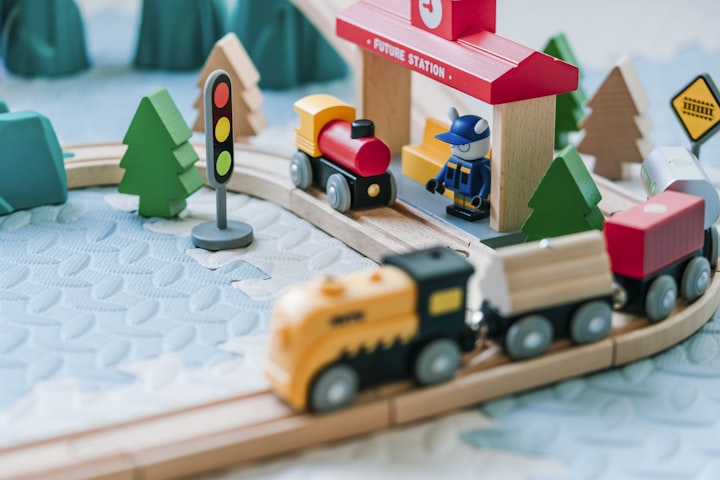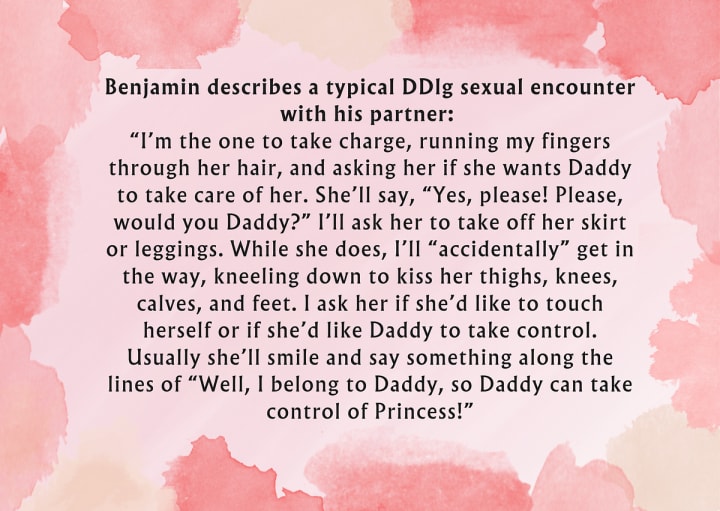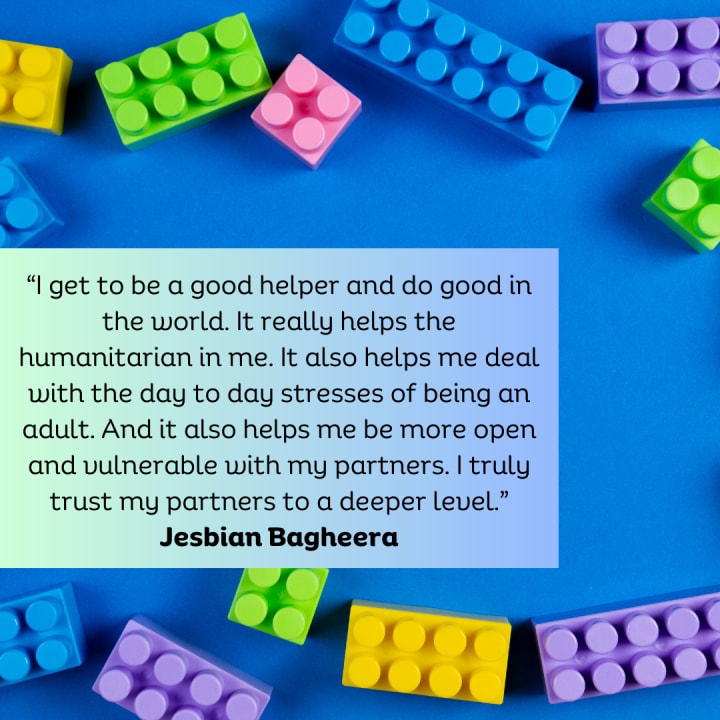Age Play: The Good, The Bad, And The Kinky
A philosophical perspective on a taboo topic

What is Age play?
When we were children, our days were filled with boundless excitement, frolicking around, playing with toys, and embracing the freedom of imagination. But as we grow older, the weight of adulthood burdens us with responsibilities, bills, and social pressures that tell us that we have to do this thing or that thing, and we can't just be kids anymore.
But why not? Why can't we still wear our favourite dress-up clothes and pretend to be someone else?
If that sounds like a slice of heaven to you, then it might be time for you to explore the realms of age play.
In the captivating world of BDSM, age play is a kink where consenting adults take on a younger or older persona than their present age.
Age play is fundamentally a form of self-expression, allowing individuals to step outside societal norms. For some individuals, this takes on the form of role-playing, where they might dress as a baby or adopt the mannerisms and language of a child. Others find fulfilment in caretaker roles, relishing in the responsibilities and nurturing of a loving parent or guardian.
While engaging in age play may not be everyone's cup of tea, there's no denying that it adds a delightful mix of variety and fascination to the enticing world of kink.
Adult Babies
One can adopt various roles in age play based on their comfort zones, interests, and preferences.
Let's start with infantilism, a form of age play where a person takes on the role of a baby. Aptly referred to as adult babies, people participating in this role-play often dress in adult-sized baby clothes, consume baby food, wear diapers, use pacifiers, and sip from bottles.
If a parent or carer is present during this special role play, they assume the role of tending to the infant, feeding it, changing its diaper, and putting it to sleep.
One perspective, shared by Mark, a then-35-year-old from South London, provides insight into the captivating allure of embracing an adult baby persona:
"It feels great sitting in a wet and soiled nappy. For a normal person it would be horrible but for me it feels comforting, while also naughty and humiliating."
While there may indeed be a sexual aspect for some participants, it is essential to acknowledge that many adult babies engage in this kink to explore a childlike state of mind. They seek to embrace the feelings of safety, security, and nurturing that accompany it. In an overwhelming and frightening world, regressing to a childlike state offers unique solace and tranquillity.

Alas, whether sexual or not, general society disapproves of the concept of adult babies, frequently labelling it as aberrant or immoral. The idea that adults should behave like children is offensive or problematic to many. However, supporters of this subculture fiercely urge us to examine our assumptions and dare us to look beyond the surface.
Exploring the notion of identity is a powerful approach to fulfilling this goal. Identity plays a dynamic role in shaping each person's unique story and is capable of undergoing transformative changes throughout their life's journey. The philosophical quandary of personal identity confronts us with a fundamental question: What makes an individual the same person over time?
In the case of adult babies, their identities as infants can seamlessly coexist with their adult selves. They fluidly transition between the two realms, navigating their unique sense of self. For them, identity is not an immovable cornerstone but a malleable entity guided by emotions and circumstances.
The adult baby subculture challenges the rigid boundaries that dictate how adults should think and behave. Proponents of the adult baby community argue that they are not hurting anyone and are merely engaging in harmless activities that bring them joy. They argue that individuals can express their identity however they see fit, as long as it does not harm others.
This subculture invites us to question the grand tapestry of societal expectations and the relentless pressure placed on individuals to embody responsibility and independence. By engaging in this discourse, adult babies beckon us to reevaluate what it means to be wholly human.

Littles
Let's move on to Littles. A Little takes on the role of a child, usually between the ages of three and ten, and immerses themselves in a delightful assortment of activities, from embracing the joy of playing with their toys and colouring to cherishing storytime and savouring every sip from a sippy cup. Littles find solace in seeking help with meals, delight in the captivating world of cartoons, and get a thrill out of dressing up.
At the core of their yearnings resides a craving for love, attention, and nurturing care bestowed by their dominant partners, who comfortably assume the roles of Daddies and Mommies.
This unique lifestyle challenges our conventional perceptions of adulthood and presents the audacious notion that escapism has a place in our lives.
In a world that demands our attention at every turn, the allure of escapism remains as strong as ever. It's a timeless concept that has captivated the human spirit for centuries, inviting us to explore fantastical realms and seek refuge from the pressures of reality.
From the enchanting tales of Greek mythology to the unforgettable plays of Shakespeare, humanity has always been drawn to the allure of transcending our ordinary lives. And in today's fast-paced society, where social media bombards us with ceaseless updates and the weight of negative news looms, the desire to escape becomes more potent than ever.
Detractors may dismiss escapism as a form of denial, but supporters understand it as a healthy coping mechanism for the stress and anxiety that weigh us down. After all, who wouldn't yearn for a respite from the relentless demands of adult life, like bills, the pressures of work, or the complexities of relationships? It's only natural to seek solace in moments that transport us back to the joy and innocence of childhood.
For countless individuals, age play provides just that - a sanctuary where they can reconnect with their inner child and rediscover the enchantment that life has to offer. It's a lifestyle that offers an escape from the weight of responsibilities, allowing them to fully embrace the present moment.
However, the key is to strike a harmonious balance by using escapism not as a total avoidance strategy but rather as a source of renewal and rejuvenation.
Putting philosophical considerations aside, it's worth noting that some individuals do incorporate sexual elements into their role-playing. Age play encompasses a vast array of complex dynamics. For instance, the "Daddy Dom/little girl" (DDlg) dynamic is a common one.
In this dynamic, a Daddy Dom takes on the role of guiding and disciplining his little girl, with both parties having explicitly consented. In return, the Little looks for the praise and attention of their Daddy, aiming to please him in every way possible. This role can go beyond the bedroom and into everyday life, where Daddy Dom will take care of his little girl's needs, such as emotional, sexual, physical, and financial. It requires high commitment and responsibility for both the Daddy and the little girl.

One of the significant factors to consider in a DDlg dynamic is that it empowers the submissive Little with a sense of safety and security. The submissive has a space where they can let go of control and responsibility and be cared for by their Daddy. This type of age play can also help the submissive feel heard and understood. The Daddy takes the time to care for his little girl, listen to her, and cherish her.
It's crucial to remember that the foundation of the DDlg age play subgenre is communication, respect, and trust. The dynamic will not work, and the relationship cannot continue to be healthy without these components. The Little must be able to express their needs and feelings to the Daddy in a clear and stable manner, and the Little must be able to create a safe haven for themselves. Since this kind of age play necessitates the submissive being exposed and put in a situation where they can be looked after by their Daddy, trust is essential.
Middles
Middles are typically older than Littles and take on the role of a child or adolescent, typically around the ages of 10 to 17. Dressed in slightly more mature attire, they exude a wider range of interests and hobbies. Increasingly defiant, they find solace in expressing their emotions with clarity. While Middles still rely on guidance and support, they begin to assert their independence, making decisions and shouldering more responsibilities.
What makes the Middle role so enchanting is the alluring blend of freedom and innocence it encompasses. In the comforting embrace of their caregivers, Middles relish feeling cared for and protected. They may also find comfort in the simplicity of childhood activities, such as colouring, playing with toys, snuggling, and helping their caregiver.

Being a Middle holds deep emotional significance for many individuals. It serves as a gateway to revisit cherished childhood memories and gain closure on unresolved issues. When you embody the role of a Middle, a whirlwind of emotions awaits, including joy, exhilaration, nostalgia, and occasionally even melancholy. Embracing this role not only provides a secure haven to explore innermost feelings but also facilitates the journey of untangling complex emotions.
Bigs/Daddy/Mommy
Let's now move on to Bigs. As the name implies, they play a distinct role compared to Littles or Middles, adding a fascinating dynamic of responsibility and care.
Within the age play community, they are often referred to as Mommy or Daddy figures. It is in this position of dominance that Bigs offer much-needed guidance, protection, and nurturing to their Littles or Middles. This framework creates an environment where rules and boundaries are established, crucial discipline is provided, and unwavering emotional support is extended.

It's worth noting that the role of a Big can vary from person to person. Some opt for a nurturing and parental approach, while others adopt a more strict and authoritative demeanour. Yet, regardless of style, the presence of Bigs brings forth profound companionship and immense personal growth within the age play community.
As a bit of insight into this role, Benjamin then 25 years old, told Mel Magazine about the unique nature of his relationship with his Little, Katie:
Katie and I stay in lockstep for everything we do: From helping her with homework, and providing life advice, to more intimate matters of picking out her clothes for her, dressing her, brushing and putting up her hair, and so on. I'm in charge of everything and pay for everything we do. There are rules about checking in with me for class, doing homework, eating all her meals, taking her medicine, as well as about cussing, missing classes, and not taking care of herself.
Finally, it is worth emphasizing once more that although these dynamics may initially seem unusual or uncomfortable to those unfamiliar with this realm, it is imperative to grasp that all involved individuals are consenting adults who have actively negotiated and agreed upon the boundaries and terms of their participation. This serves as a reminder that everyone's preferences and desires vary, and it is essential to approach the topic with open-mindedness and respect.
Is it paedophilia?
Age-play is not paedophilia.
It's two consenting adults engaging in a fantasy with one another. They might be role-playing as someone much younger than they are, or they might be pretending to be a teenager about to turn 18 and excited to go to a bar for the first time. But at the end of the day, age players aren't children or teenagers; they just like playing roles where they're younger than their actual age.
But even for those who understand the difference between age play and paedophilia, the kink still crosses boundaries that are considered inappropriate for real children. It, therefore, makes people uncomfortable with the idea of having sex with an adult pretending to be a child.
Some people believe that performing acts like these could lead one down a slippery slope towards paedophilia. While there's no scientific evidence linking one with another, it's still something that worries many people.
Controversies
While we know age play is not paedophilia, there are still plenty of other controversies linked to the kink.
The intricate dynamics of DDlg (Daddy Dom/little girl) relationships are one such issue that John Carr, a renowned expert in online child safety and Executive Board Member of the UK Council for Child Internet Safety, has brought to light. Carr argues that predatory people can take advantage of these dynamics to manipulate and groom vulnerable children. He goes so far as to refer to it as "the new currency of predatory paedophiles," pointing out the alarming ease with which this kink can be exploited.
Carr highlights DDlg-focused Facebook groups and YouTube videos on platforms that lack proper age verification measures. Moreover, he highlights the troubling trend of kids taking "kink tests" and sharing the results on their profiles, inadvertently making it easier for predators to locate and target them.
It is important to note that Carr's focus is solely on protecting the well-being of children. He does not seek to regulate the actions of consenting adults. His concern lies in the ease with which minors can access DDlg-related material, highlighting the need for increased awareness and safeguards.
Ultimately, the controversy sparked by age play stems from a difference in viewpoints. Some suggest that it reflects psychological or emotional damage and requires professional assistance. Others fail to grasp why it would be appealing at all.
But what truly drives the widespread controversy? For many, age play involves breaches of boundaries that are deemed inappropriate for actual children, which prompts discomfort with the prospect of having sexual encounters with adults who pretend to be minors.
While age-play can be a healthy and rewarding experience for some, it can cause significant harm if not engaged with the proper principles. Age play can be easily misconstrued or abused, causing psychological or physical damage to one or all participants involved. Age play can also fuel harmful power imbalances by fetishising the power dynamics of adult-child relationships, perpetuating erroneous and dangerous beliefs.
Additionally, age play can be a triggering experience for people who have experienced abuse as children. It can associate childhood with sexuality and cause traumatic triggers. Age play ought to be approached with great caution, so any idealisation of childlike pasts must be discarded in favour of a mature understanding of the complicated power dynamics present in all BDSM and age-play interactions.
Conclusion
Age play is a captivating and intricate subject that requires thoughtful consideration, open communication, and mutual consent. From a philosophical standpoint, it unveils a fascinating lens through which we can explore human behaviour, desires, and self-discovery. Whether one embraces age play or not, it is crucial to recognize that each person has unique preferences and desires that should be respected. Age play can enrich relationships with its elements of variety, depth, and creative expression, all fostered by effective communication, trust, and mutual consent.
About the Creator
Chelsea Rose
I never met a problem I couldn't make worst.






Comments
There are no comments for this story
Be the first to respond and start the conversation.